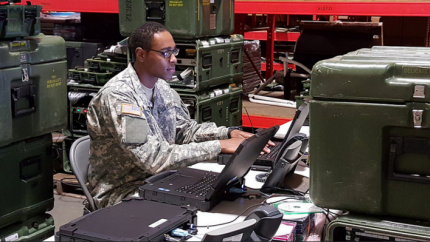Army streamlines tactical network with virtualization
Upgrades to WIN-T Increment 1 increase capability while cutting back on the amount of equipment required on the battlefield.
A soldier with the 392nd Expeditionary Signal Battalion works on the upgraded WIN-T Increment 1 network.
As the Army forges ahead with the next iteration of its battlefield tactical network, it is upgrading the initial version, which designed for at-the-halt battalion-level communications, with lighter-weight equipment and virtualized servers.
"As enemies become more capable at what they do, we need to become more capable at what we do," Staff Sgt. William Long, non-commissioned officer in charge of the upgrade effort for the 392nd Expeditionary Signal Battalion, said in a release. "This new network equipment we'll be deploying with enables us to do our job faster and more efficiently to better support the mission and our allies."
The network he referred to is the Army’s Warfighter Information Network-Tactical (WIN-T) Increment 1, which extends a command-and-control view and communications capabilities to a command post. Earlier this year, the Army awarded a contract to General Dynamics to begin full-rate production of WIN-T Increment 2, which takes communications—voice, data and imagery—to the company level via equipment mounted in vehicles. The Army eventually wants to have the network reach dismounted soldiers in the field via Increment 3, which is under development through a contract with General Dynamics that was awarded in November 2013.
In the meantime, the upgrades to Increment 1 will boost the system’s capability and security while cutting the amount of equipment required by about a third, the Army said.
"We are modernizing the WIN-T [Increment 1] network to provide improvements in readiness, security, bandwidth and capability, while reducing size, weight and power requirements so the Army's tactical network can enable a more effective and expeditionary force," said Capt. Christopher Bieber, assistant product manager for WIN-T Increment 1. "Today WIN-T Inc 1 serves about 95 percent of the Army's tactical network; the network at the halt; and it's essentially the internet for the conventional Army force. Equipment modernization efforts such as these will ensure that the WIN-T Inc 1 network can continue to support U.S. forces through 2029."
The upgrades are replacing old equipment such as routers, switches, servers and firewalls with newer versions that are both more powerful and smaller—in the case of servers, with virtualized machines—reducing the physical footprint while increasing capability, the Army said.
"This reduction frees up strategic lift, saves space for other critical items and reduces soldier burden, supporting a more expeditionary force and posturing units for improved operational readiness," said Lt. Col. Mark Henderson, product manager for WIN-T Increment 1. "Since the tactical network upgrades expand server and storage capability, they also support future network operations convergence mission requirements, the Army's common operating environment, and software convergence initiatives."
By using virtualization, the Army can cut out about a third of its transit cases and lower the weight of the cases it does use.
The Army began fielding the upgrades in October 2014. The 392nd Expeditionary Signal Battalion is the second unit overall, and the first of its kind, to receive the upgrades.
NEXT STORY: AFRL puts its new supercomputer to work





